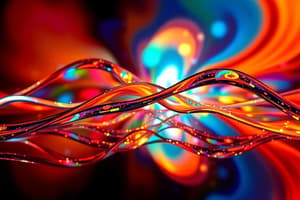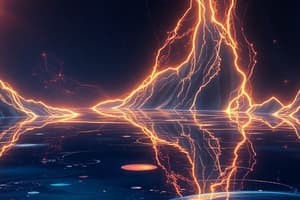Podcast
Questions and Answers
What is the definition of light?
What is the definition of light?
- A visible electromagnetic spectrum only
- A type of wave that oscillates in sound
- An optical illusion perceived by the eyes
- A form of energy that travels by electromagnetic waves (correct)
Which of the following statements describes the first law of reflection?
Which of the following statements describes the first law of reflection?
- The incident ray and the reflected ray are parallel
- The incidence ray, normal, and the reflected ray all lie in the same plane (correct)
- The angle of incidence is greater than the angle of reflection
- The angle of incidence equals the angle of refraction
Where should an object be placed in a concave mirror to form a real image?
Where should an object be placed in a concave mirror to form a real image?
- At the focal point
- At the focus of the mirror
- Outside the focus (correct)
- At the center of curvature
What is a characteristic of a virtual image?
What is a characteristic of a virtual image?
Define diffuse reflection.
Define diffuse reflection.
What does the letter 'f' represent in the formula for a concave mirror?
What does the letter 'f' represent in the formula for a concave mirror?
Which of the following is NOT a use of a convex mirror?
Which of the following is NOT a use of a convex mirror?
What principle does regular reflection follow?
What principle does regular reflection follow?
What is the second law of reflection of light?
What is the second law of reflection of light?
Which phenomena is NOT classified as a wave phenomenon?
Which phenomena is NOT classified as a wave phenomenon?
Flashcards are hidden until you start studying
Study Notes
Properties of Light
- Light is a form of energy that travels via electromagnetic waves.
Laws of Reflection
- The first law of reflection states that the incident ray, the normal line at the point of incidence, and the reflected ray all lie in the same plane.
- The second law asserts that the angle of incidence (i) is equal to the angle of reflection (r).
Reflection Concepts
- Reflection of light refers to the bouncing of light rays off a surface.
Types of Images
- A virtual image is formed by the apparent intersection of light rays and cannot be captured on a screen.
- A real image is created by the actual intersection of light rays and can be displayed on a screen.
Image Formation in Concave Mirrors
- To produce a real image in a concave mirror, the object must be placed outside the focal point.
- For an image the same size as the object, the object should be placed at the center of curvature.
Concave Mirror Formula
- In the formula for concave mirrors:
- u = distance from the object to the mirror's pole
- v = distance from the image to the mirror's pole
- f = focal length
Uses of Convex Mirrors
- Common applications include:
- Door mirrors in cars
- Mirrors at concealed entrances for traffic observation
- Safety mirrors in supermarkets
Advantages of Convex Mirrors
- Convex mirrors provide a wider field of vision compared to flat mirrors, making them ideal for vehicle side mirrors.
Types of Reflection
- Diffuse reflection involves light scattering off rough surfaces such as books or tables.
- Regular reflection occurs when light reflects off smooth surfaces, like mirrors.
Wave Phenomena
- The five phenomena of waves are:
- Reflection
- Refraction
- Diffraction
- Interference
- Polarization
Focal Length Equation
- The formula for the focal length of spherical mirrors is given by:
- 1/f = 1/u + 1/v
- Here, v represents the distance from the mirror to the image.
Magnification
- Magnification can be calculated as the ratio of image distance to object distance or the ratio of image height to object height.
Studying That Suits You
Use AI to generate personalized quizzes and flashcards to suit your learning preferences.




